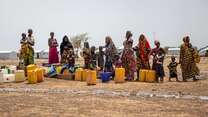This paper aims to articulate why markets are at the core of the IRC’s programming in economic recovery and development and beyond and how the IRC does and should engage with markets across sectors. It will establish a common understanding of markets and how they are affected by crises and explain and define the IRC’s continued approach to working with markets for analysis and response in all stages of crisis and recovery. Critically, it will highlight how working with markets is fundamentally linked to the IRC’s strategy, across outcomes.
Whereas international development actors have worked through market systems for decades, the humanitarian sector has only recently begun to recognize their importance. Industry standards are increasingly calling for market analysis, as evidenced in the 2010 Minimum Economic Recovery Standards guidelinesi, the 2011 Sphere handbook’s guidelines for food security assessmentsii and the 2012 Livestock Emergency Guideline Standardsiii, a Sphere companion initiative. WFP food security analyses for baseline, emergency and monitoring contexts now include market components. Meanwhile, the dramatic increase in programs that involve cash-based interventions (themselves a type of market-based programming) and local procurement since the 2004 tsunami in Southeast Asia has established these market-based approaches within core humanitarian interventions. Elsewhere, market strengthening approaches have been mainstreamed by food security stakeholders including WFP and FAO; examples include WFP’s and their Home Grown School Feeding program, both of w
The evidence for the value and benefits of market-based programming, though incomplete, is growing. A 2012 study of a large-scale USDA pilot program found that relief supplies procured through local and national markets were usually more cost-effective and efficiently delivered than supplies shipped from the USv. Meanwhile, emergency response and early recovery efforts that ignore market dynamics can actually cause harm, impede economic recovery, contribute to tensions and even encourage dependency on aidvi.
Working to support the recovery, development and strengthening of markets is essential to achieving numerous outcomes in the IRC’s new strategy. Most obviously, market-based programming can help the IRC to realize each of the economic wellbeing sub-outcomes. For example, by supporting access to goods and services (such as staple foods and transportation) and reinforcing purchasing power through either cash transfers or income-generation opportunities, the IRC can ensure that people meet their basic needs and are food secure, while tapping into the pre-existing supply networks offered by markets. Programs addressing gaps in market systems can create opportunities for people to generate more income and build assets. Finally, identifying and helping to address inequities in market systems (for example, systems where market actors are almost all men) helps to ensure that women are able to use and control resources. However, market-based programming is equally relevant to other outcome areas, including health, education and power. Market-based delivery of health and education goods and services can be a highly effective means of lowering costs, providing greater access and offering more choice and control for people to determine what is best for them. Meanwhile, promoting equitable access to different parts of market systems and financial services is an essential mechanism for the empowerment of women and marginalized groups within households and communities.



